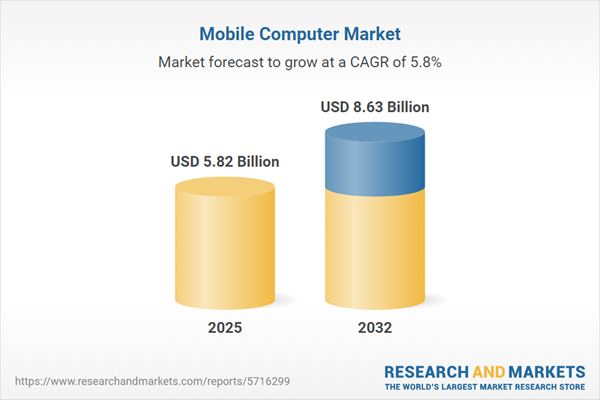Speak directly to the analyst to clarify any post sales queries you may have.
Senior decision-makers require reliable market intelligence to navigate the evolving mobile computer sector. This page distills the most actionable insights on growth drivers, operational challenges, and technology developments in the mobile computer market, supporting informed strategy in a dynamic business landscape.
Market Snapshot: Mobile Computer Market Trends and Dynamics
The global mobile computer market achieved a value of USD 5.50 billion in 2024 and is set to reach USD 5.82 billion in 2025, reflecting a steady compound annual growth rate of 5.80%. Projections estimate market value to rise to USD 8.63 billion by 2032, driven by increasing enterprise adoption of high-performance mobile computer solutions for business modernization. Organizations across sectors are leveraging advanced devices to connect teams, enhance workflows, and meet a wide spectrum of digital requirements. Product innovation from market leaders and new entrants is contributing to sector-wide transformation, offering flexible platforms that adapt to both industry-specific and general business needs.
Scope & Segmentation: Strategic Analysis for Senior Leaders
This report provides a detailed breakdown of the mobile computer market to guide executive decisions in investment, procurement, and risk management. Each segment reflects key operational requirements and emerging industry challenges.
- Device Types: Handheld computers, industrial PDAs, pocket PCs, laptops, rugged devices, tablets, and vehicle-mounted computers support diverse functional needs spanning logistics, field operations, clinical work, and administrative duties.
- Operating Systems: Android, iOS, Linux, and Windows platforms ensure adaptability to organizational policies and enable broad software compatibility in both controlled and dynamic environments.
- End Users: Businesses, healthcare providers, educational institutions, consumers, and public sector entities require tailored devices and integration frameworks to address regulatory, security, and workflow demands in their specific domains.
- Connectivity Technologies: Bluetooth, Wi-Fi, and cellular networks (ranging from 3G through 5G) enable flexible deployment for both centralized and distributed operations, supporting mobility and productivity.
- Processor Types: AMD, ARM, and Intel architectures power energy-efficient and high-performance devices suitable for applications such as diagnostics, asset tracking, and mobile management.
- Distribution Channels: Direct sales, retail, and digital commerce facilitate efficient access and streamlined procurement, helping enterprises stay current with evolving solutions and technologies.
- Regions: Americas, Europe, Middle East & Africa, and Asia-Pacific each present varying levels of infrastructure maturity, shaping how organizations prioritize technology adoption and define their investment strategies.
- Key Companies: Lenovo, HP, Dell, Apple, Acer, ASUSTeK, Microsoft, Samsung, Xiaomi, and Huawei bring differentiated approaches to innovation and partnership models for enterprise clients.
Key Takeaways: Mobile Computer Market Strategic Insights
- Prioritize device procurement strategies focused on security, regulatory compliance, and operational continuity, particularly for industries with high data sensitivity.
- Adopt artificial intelligence and edge analytics to automate predictive maintenance and improve user interaction, enhancing proactive management across enterprise device portfolios.
- Align technology investment with local infrastructure capabilities and regulatory context to maximize growth while mitigating entry and operational barriers.
- Embrace modular hardware and integrated platforms that streamline large-scale deployment, facilitate centralized management, and support lifecycle value for enterprise device fleets.
- Strengthen cross-industry partnerships to enhance supply chain resilience, emphasizing secure end-to-end connectivity and robust cybersecurity measures to adapt to evolving market demands.
Tariff Impact: Navigating Global Supply Chains
Recent United States tariff updates have prompted manufacturers to revisit procurement and assembly processes across the mobile computer market. In response, leading companies are employing nearshoring tactics, regional assembly, and dynamic pricing strategies to address supply chain vulnerabilities. Simultaneously, investment in digital trade compliance and agile logistics systems is enabling organizations to maintain delivery standards, align with emerging regulations, and sustain operational efficiency as global trade dynamics continue to shift.
Methodology & Data Sources
The insights in this report are underpinned by direct interviews and surveys with mobile computer manufacturers, distribution partners, and end users. This primary research is complemented with data from regulatory filings, industry-leading publications, and validated public records, ensuring robust, reliable intelligence for executive analysis.
Why This Mobile Computer Market Report Matters
- Equips executives with critical guidance on technology integration and procurement strategy, enabling preparedness for ongoing market and operational changes.
- Facilitates agile adaptation of supply chains and compliance frameworks, helping reduce risks amid complex international regulatory developments.
- Supports sustained competitive positioning by aligning business strategy with local market requirements and broader sustainability objectives.
Conclusion
This report provides objective, actionable market intelligence for senior leaders seeking to guide investment, optimize procurement, and build enterprise resilience in a continuously evolving mobile computer sector.
Additional Product Information:
- Purchase of this report includes 1 year online access with quarterly updates.
- This report can be updated on request. Please contact our Customer Experience team using the Ask a Question widget on our website.
Table of Contents
3. Executive Summary
4. Market Overview
7. Cumulative Impact of Artificial Intelligence 2025
Companies Mentioned
The companies profiled in this Mobile Computer market report include:- Lenovo Group Limited
- HP Inc.
- Dell Technologies Inc.
- Apple Inc.
- Acer Incorporated
- ASUSTeK Computer Inc.
- Microsoft Corporation
- Samsung Electronics Co., Ltd.
- Xiaomi Corporation
- Huawei Technologies Co., Ltd.
Table Information
| Report Attribute | Details |
|---|---|
| No. of Pages | 195 |
| Published | October 2025 |
| Forecast Period | 2025 - 2032 |
| Estimated Market Value ( USD | $ 5.82 Billion |
| Forecasted Market Value ( USD | $ 8.63 Billion |
| Compound Annual Growth Rate | 5.8% |
| Regions Covered | Global |
| No. of Companies Mentioned | 11 |









